BUTTERFLY
FAQ
One could spend a lifetime lost in a butterfly wing
~K. D’Angelo
In most cases, moths are active at night (nocturnal) and butterflies are active during the day (diurnal). Butterflies sometimes flaunt bright colors on their wings which can be seen well in the sunlight, while moths are typically more dull-colored to provide camouflage at night.
Butterflies
Butterflies are often brighter and active during the day (diurnal)

Moths
Moths wear dull colors and are often active during the night (nocturnal)

Butterfly antennae are straight with knobs at the end.
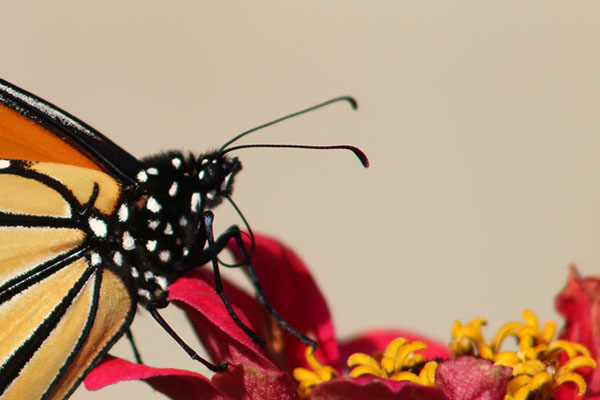
Moth antennae look more feather-like.
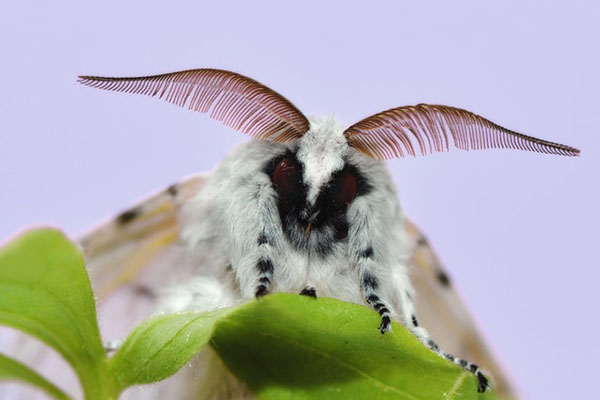
Butterfly caterpillars most often develop into hard chrysalises which are hung up by silken lines.
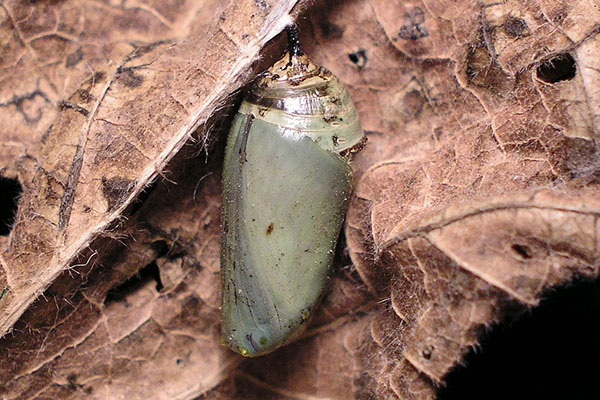
Moths develop cocoons that are often buried under leaves or soil and may be wrapped in a silken casing.

When at rest, a butterfly’s wings are usually folded up.
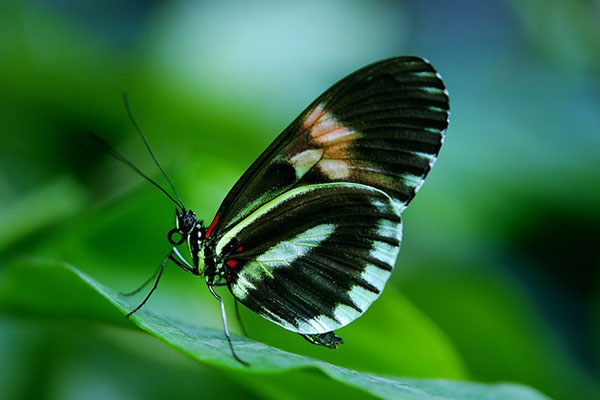
While moths are typically spread out.
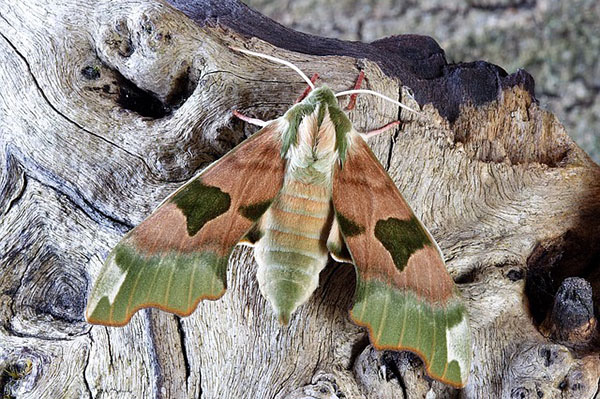
The word Lepidoptera is derived from the Latin words “lepido” meaning scale, and ” ptera” meaning wings. Lepidoptera literally means scale wings, referring to the minute scale-like structures on the wings of both butterflies and moths.
The largest butterfly in the world is the Queen Alexandra’s Birdwing (Ornithoptera alexandrae) found in the rain forests of New Guinea. It can have a wingspan of up to 1 foot (30 cm).
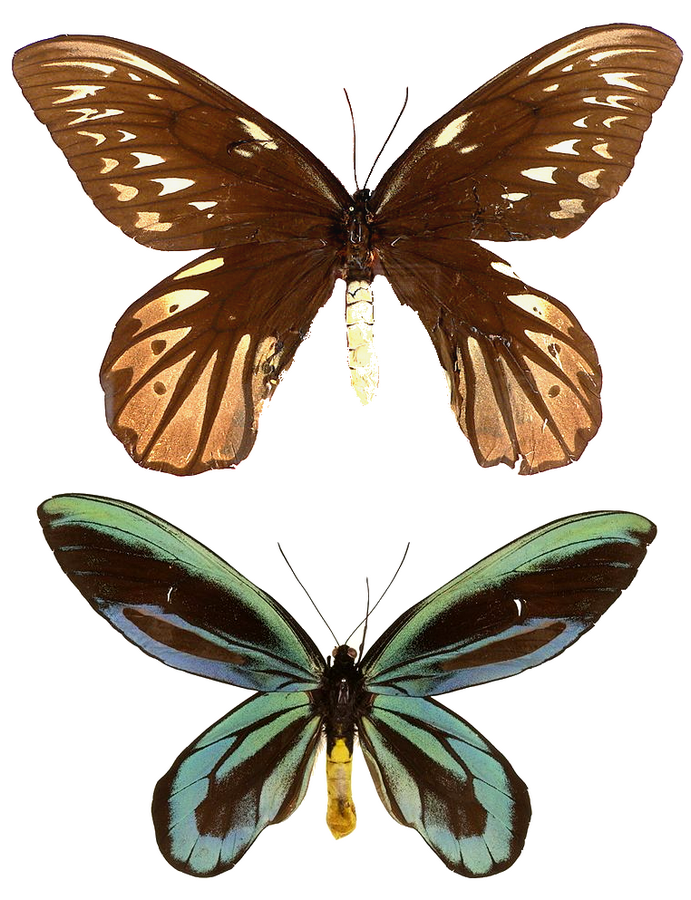
The smallest butterfly in the world is the Western Pygmy-Blue (Brephidium exilis). The tiny Western Pygmy Blue measures only 3/8 – 3/4 inch (10- 19 mm) It can be found in East Oregon, South Western United States, east to Nebraska, parts of Mexico and South America.
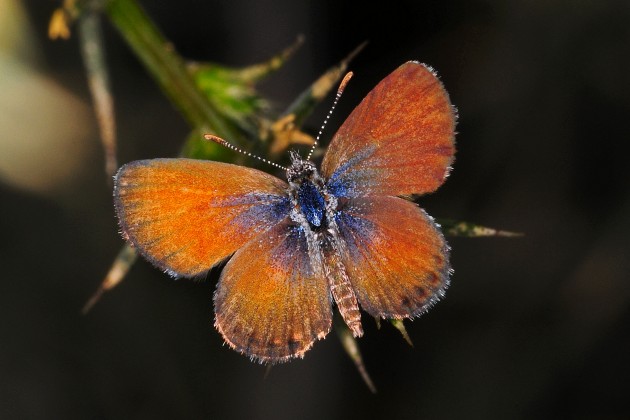
Most butterflies can see ultraviolet colors that are invisible to the our eyes. Many flowers, host plants and butterfly wings have this ultraviolet color so butterflies can easily distinguish them.
A group of butterflies is called a “Flutter”.
Butterflies cannot hear, but they can feel vibration and they have an excellent sense of smell. Butterflies can smell or “taste” with the tiny receptors they have on their feet, antennas and in some cases even on their abdomens.
Simply put, the pupa stage of a moth is called a cocoon and the pupa stage of a butterfly is called a chrysalis.
Butterflies have a very special life cycle. They actually change shape as they go through their life cycle. This change is called metamorphosis. Butterflies go through a complete metamorphosis starting as an egg, then caterpillar, then chrysalis and then finally an adult butterfly. An adult butterfly does not not grow once emerged from its chrysalis.

Egg

Caterpillar
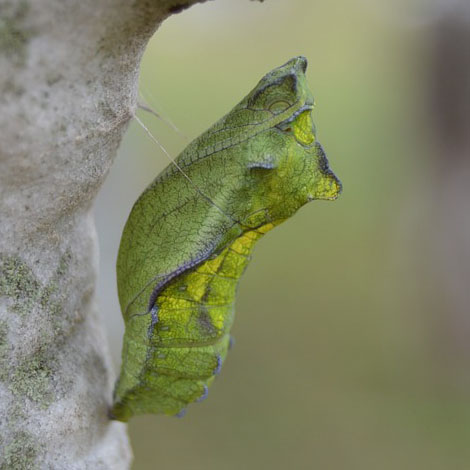
Chrysalis
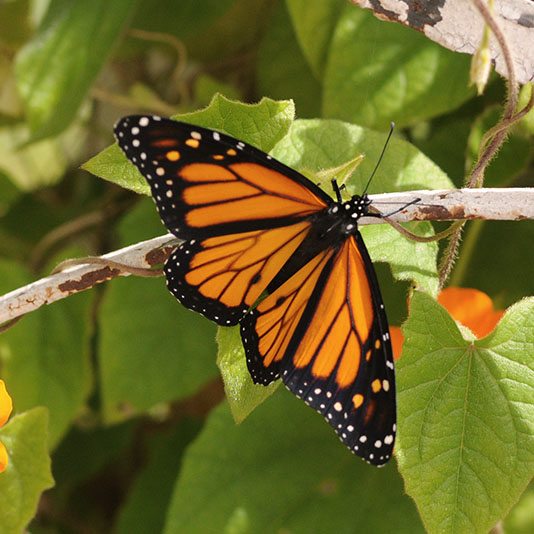
Butterfly
In butterflies the larva is commonly referred to as a caterpillar. Larva aka caterpillars have enormous appetites and eat large amounts of leaves as they grow. Caterpillars molt their skin several times (called an instar) as they grow.
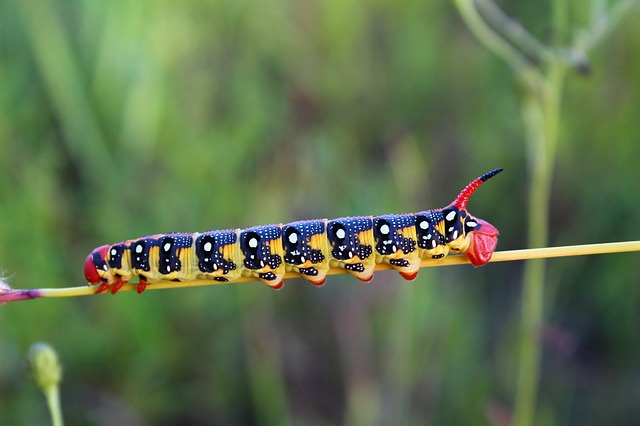
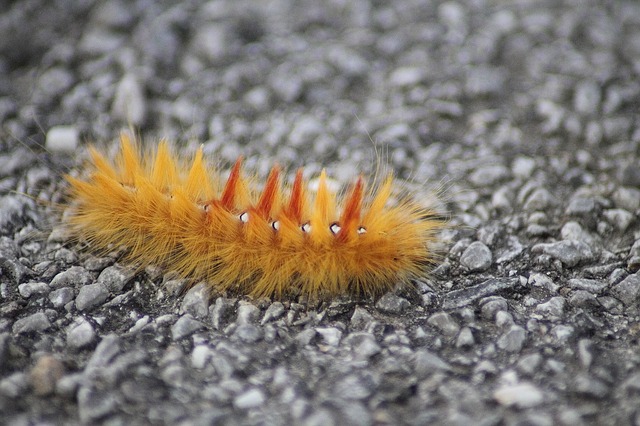

In butterflies the pupa is commonly referred to as a chrysalis or a cocoon. When the caterpillar is done growing, the last molting reveals a chrysalis or in moths, a cocoon. The development of the adult butterfly takes place inside of the chrysalis.
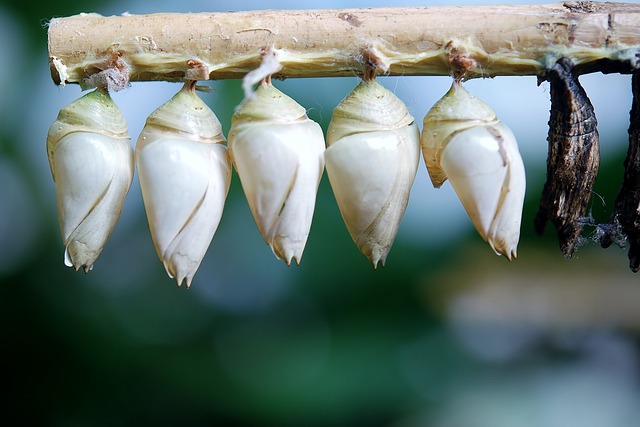
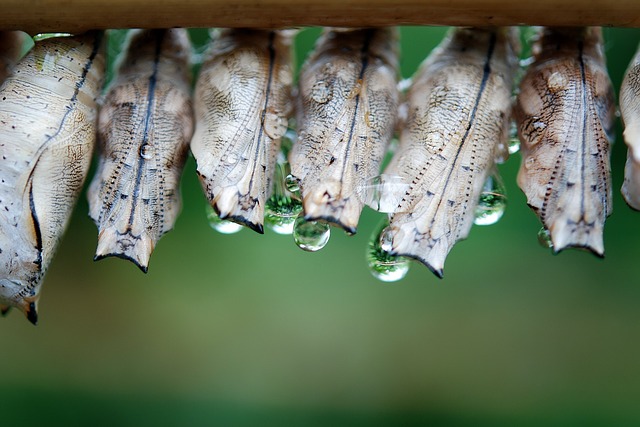
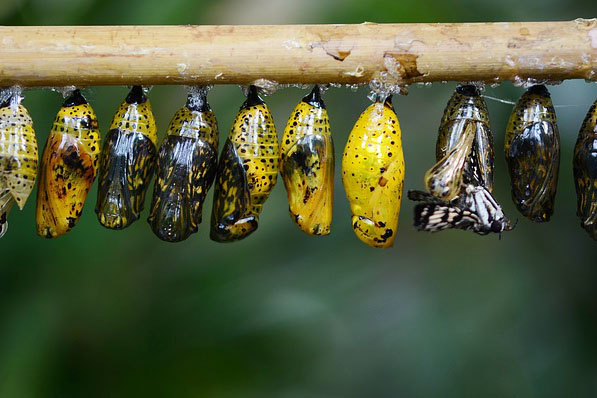
Butterflies can be found just about everywhere imaginable. They can live in forests, mountains, deserts, jungles, grasslands and marshes. Butterflies are even found in the Arctic regions but not typically above 18,000 feet where it is too cool for them to survive. Butterflies nectar, escape enemies, mate and migrate in all sorts of environments as they adapt to keep their species alive.
Butterflies have build-in mouth parts called a proboscis, which is a soda-straw like tube, allowing butterflies to slurp nectar from deep inside a flower. When not in use, they coil this “tube” or proboscis up close to their head.
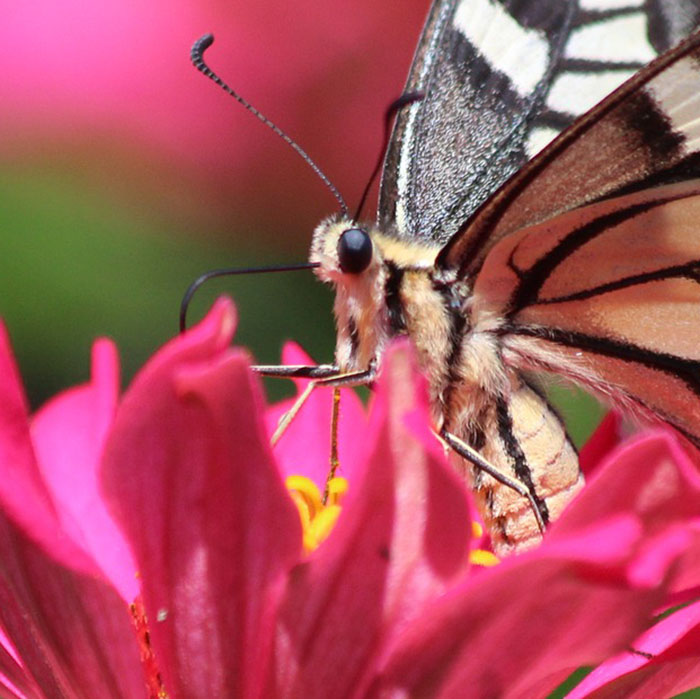
Adult butterflies drink nectar from flowers. Some butterflies may also get nourishment from nutrient rich materials such as mineral rocks, mud, rotting fruit or dung.
Lepidopterists are entomologists who study butterflies and or moths.
In many species the males and female butterflies look alike, in some species however, there may be some subtle differences. Sometimes males are smaller and more brightly colored, while the females tend to be larger (as they carry the eggs) and less brightly colored. Males in some species have “clasp” located on the tips of their abdomens, while other males could have “scent glands” located on the wing, that is the case of the monarch butterfly.

In most species it would be hard to tell in a quick glance whether you were looking at a male or female butterfly, but if you watched a butterfly’s behavior, you might get a clue to its gender. Females are typically preoccupied with egg laying, while the males often tend to be the ones you will see puddling (drinking up nutrients), protecting their territories and chasing females about.
An adult butterfly probably has an average life-span of about one month. In the wild, most butterflies lives are shorter than this because of the dangers provided by predators, disease and humans. The smallest butterflies may live only a week or so, while a few butterflies, such as Monarch, Mourning Cloaks and Tropical Heliconians can live up to nine months.
In areas where temperatures drop below freezing during part of the winter, at least one stage in a butterfly species’ life cycle must be resistant to freezing if the species is a resident. Most butterflies that live in cold climates spend the winter as caterpillars, while almost as many spend the winter as a chrysalis. A few species spend the winter as adults, hibernating in holes in trees, in crevices in man-made structures, or in other shelters. A very few species spend the winter as eggs. Some species may migrate to warmer climates for the winter, such as the monarch butterfly.
Butterflies are cold-blooded, which means that their body temperatures are not regulated on their own. A butterfly’s body temperature is instead affected by the temperatures of its surroundings. If it is too cold butterflies must warm up their bodies in order fly, if it is too warm they must cool down their bodies in order to fly. The optimum body temperature for a butterfly to fly is between 82 °-102° F. Butterflies can fly in air temperatures as cool as 55° F but they must regulate their body temperature and keep it warm by practicing behavioral tactics such a shivering their wings or basking in the sun. If the temperature is over 108° F a butterfly body temperature may become to warm to fly and it may have to cool its body temperature.
Yes, some butterflies migrate. Many butterflies that spend the summer in temperate North America cannot survive the cold northern winters. Each year, as the weather becomes cooler, many butterflies can be found moving southward in groups of thousands. Cloudless Sulphurs, Mourning Cloaks, Question Marks, Queens and Monarchs are among them. Exactly where all of these butterflies go is not known. In early spring a reverse migration takes place. Butterflies from Mexico and the southern United States fly north. For most of these species the northward dispersals are gradual, but, in especially good years, one can see Painted Ladies, Cloudless Sulphurs or Clouded Skippers streaming northward along migratory routes.
Monarchs are the most well known of migratory butterflies. We know that most of the Monarchs from west of the Rocky Mountains spend the winter along the California coast while those from central North America spend the winter in roosts in the mountains of central Mexico. Monarchs from the Atlantic seaboard also migrate. Some are thought to go to Mexican mountain overwintering sites, while others may travel to, and through, Florida, perhaps flying on to undiscovered sites in the Caribbean and/or the Yucatan Peninsula.
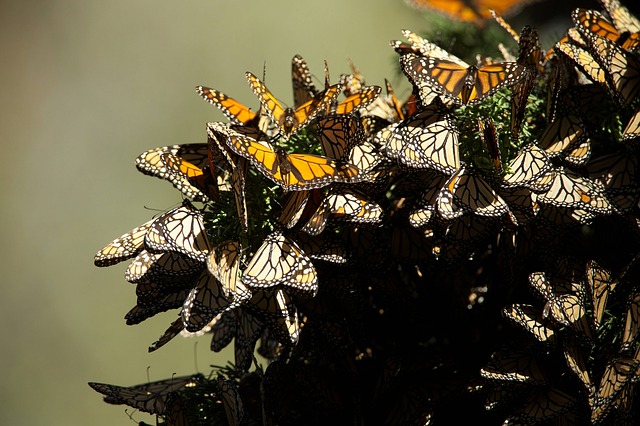
Butterflies have strong muscles in their thorax which force their wings up and down on a fulcrum basis. They actually go in a slanted figure 8 motion that propels them forward through the air in the same principle as an airplane.
Butterflies can communicate with each other (same or different species) by color, chemicals, sound, and physical actions. Color patterns in their wings are used to signal their sex or species to each other. Chemical pheromones are used by both sexes of some butterflies to attract the opposite sex or to signal species identity in courtship. A few butterflies make clicking sounds to protect their space. Some chrysalides make clicking sounds to attract ants that in turn protect them. Physical actions such as aggressive flight or postures are used in courtship or to protect resources such as an important flower. Caterpillars of some species produce sugary substances for ants which in turn protect the caterpillars.
Some butterflies have inhabited our planet for at least 130 million years. They showed up about the same time flowering plants did. We know this because of fossil records that butterflies have left behind. Some butterflies have changed very little since the dawn of time, others have changed greatly and some have become extinct.
Those that taste good to a predator often fly fast and erratically, or continue to move their wings even when stopped on a flower. Butterflies that taste bad or have toxins in their bodies don’t have to fly as fast because most predators leave them alone.
Butterflies who might taste good to predators need to hide from them therefore they may be camouflaged. Butterflies that taste bad or are toxic to predators have no need to hide. These butterflies display bright warning colors as a way to remind predators that they taste bad or are toxic. Some butterflies also use their colors to attract mates.
Butterflies are very important in our world and this fact often gets overlooked. There are about 12,000 different species of butterflies in the world. Butterflies play a part in pollinating the Earth’s plant population and they are also an important part of the food chain.
Because of our activities and destruction of butterfly habitats, some butterflies have become rare, threatened, endangered and even extinct. The Xerces Blue Butterfly was the first butterfly in North America to become extinct due to human activity. About a dozen species of butterflies are currently threatened or endangered in the United States. To increase awareness about the importance and value of butterflies, some states have adopted official state butterflies. California’s is the California Dogface butterfly.
No one really knows for sure where the word “butterfly” comes from. Some have theorized, however, that it originates from Europe, where people commonly saw yellow colored Sulfurs. It is thought that people referred to these Sulfurs as “Butter-Colored Flies” which may have evolved into the word butterfly or “buterfleoge” in Old English. Others tell the story of how the word butterfly may come from the Old English belief that witches took on the shape of butterflies and fluttered about stealing milk and butter. What ever the case, butterflies or “flutter-bys” always have seemed to capture the imagination and hearts of people.
